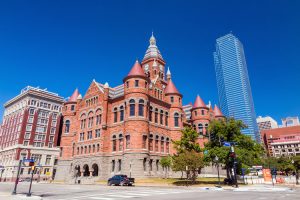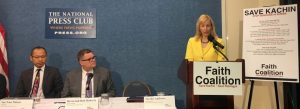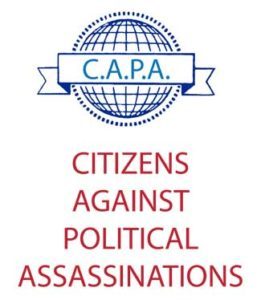Editor’s Choice: News & Views from June-December, 2018
This archive of assassination-related news and commentary for the calendar year 2018 is a joint project between CAPA and the Justice Integrity Project. The material below consists of selected excerpts from significant news stories or commentaries  regarding alleged political assassinations or attempts. The materials are arranged in reverse chronological order and focus primarily upon news arising from the 1960s murders of President John F. Kennedy (shown in a file photo), his brother Robert Kennedy, and the Rev. Martin Luther King, Jr. Included also are several reports regarding other alleged political murders of prominent international leaders, or attempts.
regarding alleged political assassinations or attempts. The materials are arranged in reverse chronological order and focus primarily upon news arising from the 1960s murders of President John F. Kennedy (shown in a file photo), his brother Robert Kennedy, and the Rev. Martin Luther King, Jr. Included also are several reports regarding other alleged political murders of prominent international leaders, or attempts.
CAPA welcomes your submission of additional items or any comments (including corrections) of items listed below. It is requested that new items be submitted in the format below: Publication name, headline with hotlink to URL, author, date, and brief excerpt. Correspondence should be sent to this site’s editors, Glenda De Vaney or Andrew Kreig, via email.
August
Aug. 6
 New York Times, Attack on Maduro: 2 Blasts, a Stampede and a ‘Flying Thing,’ Ana Vanessa Herrero and Nicholas Casey, Aug. 6, 2018 (print edition). A drone attack that failed to kill President Nicolás Maduro, right, of Venezuela unfolded on live TV and in front of many witnesses: “It was like, bang, I had never heard a sound like that in my life.”
New York Times, Attack on Maduro: 2 Blasts, a Stampede and a ‘Flying Thing,’ Ana Vanessa Herrero and Nicholas Casey, Aug. 6, 2018 (print edition). A drone attack that failed to kill President Nicolás Maduro, right, of Venezuela unfolded on live TV and in front of many witnesses: “It was like, bang, I had never heard a sound like that in my life.”
In the presidential box stood the small cadre who run the country: a loyal general who was now the interior minister, the chief judge of the Supreme Court and Nicolás Maduro, the president, who looked down at a parade of national guard troops.
Mr. Maduro, bedecked for the ceremony with the gold chain and tricolor sash of his office, was ending his speech Saturday afternoon on the topic that is top of mind for every Venezuelan: the ravaged economy, which has left much of the population desperate for food, emptied the hospitals of medicine and driven hundreds of thousands to leave the country. Before a loyal audience, the president tried to sound an optimistic tone on improvements to come, despite Venezuela’s dire condition.
July
July 26
![]() WhoWhatWhy, Analyzing the New JFK Revelations, Bill Simpich, July 26, 2018. Review of New CIA and FBI Documents That Change Cold War History.
WhoWhatWhy, Analyzing the New JFK Revelations, Bill Simpich, July 26, 2018. Review of New CIA and FBI Documents That Change Cold War History.
Bill Simpich is a civil rights attorney in the San Francisco Bay Area. He is on the board of directors of the Mary Ferrell Foundation, an organization focused on the study of documents related to the 1960s assassinations, Watergate, and Iran-Contra. In the following essay, he offers a look at some of the gems found in the new JFK document releases and how to speed up the discovery of future finds.
More than 50 years after the assassination of President John F. Kennedy, thousands of government documents related to his death are still under classified lock and key.
By law, all of the remaining secret documents were supposed to have been released last year. President Donald Trump approved the release of approximately 35,000 files in 2017. But he delayed the publication of many other documents in full or in part until 2021 — when the winner of the 2020 presidential election will have another chance to review them for possible declassification.
The difficult job of understanding why a president was murdered, and unpacking the Cold War path that America was treading, involves working through the minutiae — the “boring” material — so that the little puzzle pieces can fit together to form a coherent bigger picture.
July 20
SAVE THE DATE
CAPA EVENT
“THE LAST WITNESSES – REVEALING THE TRUTH”
NOVEMBER 15, 2018
12 NOON – 9 PM
THE OLD RED MUSEUM, DALLAS, TEXAS
HISTORIC FORMER COURTHOUSE OVERLOOKING DEALEY PLAZA
July 19
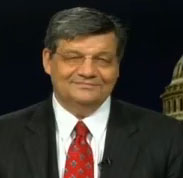 Justice Integrity Project, Myanmar Anti-Genocide Advocates Raise Alarms, Andrew Kreig (shown at right), July 19, 2018 (updated). Amid continuing government-sponsored, mass atrocities in the southeast Asian nation of Myanmar, an interfaith coalition is ramping up anti-genocide advocacy nationally this month, particularly in Washington, DC.
Justice Integrity Project, Myanmar Anti-Genocide Advocates Raise Alarms, Andrew Kreig (shown at right), July 19, 2018 (updated). Amid continuing government-sponsored, mass atrocities in the southeast Asian nation of Myanmar, an interfaith coalition is ramping up anti-genocide advocacy nationally this month, particularly in Washington, DC.
The Interfaith Coalition To Stop Genocide In Burma, for example, is calling on the U.S. government to more aggressively intervene in the political assassinations and other government-organized political crimes — and to enact tough sanctions against the government of Myanmar, which was formerly (and sometimes still) known as Burma.
Faith Coalition member and spokeswoman Nicolee Ambrose, who recently returned from a visit to the region, opened a news conference July 9 at the National Press Club with reactions from her recent visit to Rohingya refugee camps in Bangladesh.
“Since August 2017,” the coalition leaders said in their overview, “more than 700,000 Rohingya refugees have fled Burma due to horrific conditions of torture, rape, and murder at the hands of the Burmese government. The Kachin Christians are now facing the same treatment as the genocide continues.”
The Rohingya are primarily Muslims from the country’s western province Rakhine on the Bay of Bengal. Kachin, a northern province, is reported as overwhelmingly Christian, stemming from long ago missionary work.
“We cannot sit and do nothing,” said Rev. Bob Roberts, Jr. Senior Pastor at the Northwood Church in Dallas, Texas and co-chair of the Faith Coalition. Roberts shown at center of the Justice Integrity Project photo of the news conference above. Ambrose is at right and Kachin National Organization USA President Sut Nau Ndayu is at left.
“We are calling on President Trump to help the people of the region,” continued Roberts. “Our brothers and sisters cannot keep suffering at the hands of these thugs. Kachin and Rohingya people need to be repatriated to their country and villages with full rights.”
New York Times, Myanmar’s Military Planned Rohingya Genocide, Rights Group Says, Hannah Beech, July 19, 2018. Myanmar’s military systematically planned a genocidal campaign to rid the country of Rohingya Muslims, according to a report released on Thursday by the rights-advocacy group Fortify Rights based on testimony from 254 survivors, officials and workers over a 21-month period.
The 162-page report says that the exodus of around 700,000 Rohingya Muslims to Bangladesh last year — after a campaign of mass slaughter, rape and village burnings in Rakhine State in Myanmar — was the culmination of months of meticulous planning by the security forces.
Fortify Rights names 22 military and police officers who it says were directly responsible for the campaign against the Rohingya and recommends that the United Nations Security Council refer them to the International Criminal Court.
“Genocide doesn’t happen spontaneously,” said Matthew F. Smith, a former Human Rights Watch specialist on Myanmar and China who is chief executive officer of Fortify Rights. “Impunity for these crimes will pave the path for more violations and attacks in the future.”
Fortify Rights, ‘They Gave Them Long Swords; Preparations for Genocide and Crimes Agianst Humanity against Rohingya Muslims in Rakhine State, Myanmar, Staff report, July 19, 2018. The Myanmar military’s ostensible trigger was on August 25, 2017, when Rohingya militants, armed mostly with sticks and knives, attacked several police outposts in northern Rakhine State, reportedly killing 12 officials. Members of ARSA explained to Fortify Rights their involvement in and knowledge of these attacks.
 Almost immediately after these attacks, the Myanmar authorities moved into Rohingya villages and evidently activated groups of non-Rohingya residents, some of whom had earlier received arms and training by the Myanmar military. Armed with guns, swords, and knives, these groups of civilian perpetrators joined state security forces in using lethal force against Rohingya civilians in villages throughout northern Rakhine State.
Almost immediately after these attacks, the Myanmar authorities moved into Rohingya villages and evidently activated groups of non-Rohingya residents, some of whom had earlier received arms and training by the Myanmar military. Armed with guns, swords, and knives, these groups of civilian perpetrators joined state security forces in using lethal force against Rohingya civilians in villages throughout northern Rakhine State.
“We know the people who came with the army,” said “Abdul Rahman,” 41, an eyewitness and survivor of a Myanmar Army-led massacre in Chut Pyin village — also known as So Farang — in Rathedaung Township on August 27, 2017. “They were Rakhine from a neighboring village. I know them well. I could recognize them. The army shot people and then the Rakhine cut them.”
For several weeks, the Myanmar Army, Police, and non-Rohingya civilians raided hundreds of Rohingya villages, committing massacres of men, women, and children, systematic rape of women and girls, mass arbitrary arrest of men and boys, and widespread and systematic
arson attacks. More than 700,000 Rohingya fled to Bangladesh in a matter of weeks, resulting in the fastest refugee outflow since the Rwandan genocide.
“Rashida,” 50, watched as Myanmar Army and Lon Htein soldiers dragged her two adult sons from her home in Kha Maung Seik village — also known as Fora Bazaar — in Maungdaw Township on August 27.
“I was watching the whole time,” she told Fortify Rights just days after the incident. “The soldiers made them lay down on the ground, and then they cut their necks. We were shouting and crying.”
Conservative estimates suggest that in the span of a few weeks, soldiers and police with the support of armed non-Rohingya civilian-perpetrators killed at least several thousand Rohingya civilians—if not tens of thousands—from hundreds of villages throughout the three townships of northern Rakhine State.
An annex to this report provides extensive documentation of similar crimes perpetrated against Rohingya in upwards of 40 villages in Maungdaw Township during military-led “clearance operations” in 2016. Fortify Rights documented a chilling continuity of killings by state security forces from 2016 to 2017, differing only in scale.
July 18
Lobster Magazine, Powers, Angleton, Morley and Dallas, William Kelly, Electronically published July 2018 for Winter 2018. Mainstream media journalists seldom take on the delicate subject of the assassination of President Kennedy to discuss it in a serious way. An example of this was Thomas Powers’ recent review of Ghost, Jefferson Morley’s biography of James Jesus Angleton: Powers came close but doesn’t know enough about the subject to do more than try – and fail – to discredit Morley and dismiss his work on the assassination as irrelevant.
We have the JFK Collection at the National Archives (NARA); we have the Freedom of Information Act (FOIA) to request even more relevant records; and we have
the Mary Ferrell and Black Vault websites to funnel the relevant records to the analysts who can properly interpret them.
So we can now investigate the assassination of the President Kennedy by narrowing the research to the relevant records, based on our knowledge of the evidence. What cannot be quarreled over is the determination that the JFK chronology and serials do not support the Warren Commission conclusion that one man alone was responsible for the assassination: the modus operandi of the murder was that of a covert intelligence operation conducted by a domestic intelligence network, and not the Cubans, the Soviets, or the Mafia.
While normal criminal investigations attempt to collect evidence that can
be used in a court of law, a counter-intelligence investigation, such as we are
now conducting, attempts to determine the total truth, something that can be
known in our lifetime. Justice however, will never be served.
*
 William Kelly, shown at right, is a New Jersey based freelance journalist and historian. He is the author of two books, “300 Years at the Point” and “Birth of the Birdie” and is working on “The Divine Skein at Dealey Plaza – How JFK Was Killed and How They Got Away With It.” He is the co-chairman of the Research Committee of Citizens Against Political Assassinations (CAPA-US.org).
William Kelly, shown at right, is a New Jersey based freelance journalist and historian. He is the author of two books, “300 Years at the Point” and “Birth of the Birdie” and is working on “The Divine Skein at Dealey Plaza – How JFK Was Killed and How They Got Away With It.” He is the co-chairman of the Research Committee of Citizens Against Political Assassinations (CAPA-US.org).
JFKcountercoup, Going Deep into the Records – Assumptions, False Assumptions and Hypothesis, William Kelly, July 17, 2018. Kelly’s Response to Powers’ Review of Morley’s Ghost.
We can continue to narrow the search of the universe of more than 5 million JFK assassination records to identify the most relevant and significant ones by applying a few basic assumptions, disregarding a few false assumptions, adopting some hypothetical theories and devising some direct hypothesis, like scientists do.
Before applying a few basic assumptions, we can disregard two false assumptions that many people have accepted as fact, but when upon closer examination, have been proven false, especially the first false assumption that President Kennedy was killed by one man alone: Lee Harvey Oswald.
July 12
 Black Op Radio, 50 Reasons For 50 Years, Episode 9, Host Len Osanic, July 12, 2018 (video-audio). 50 Lies the Warren Commission Would Like You To Believe.
Black Op Radio, 50 Reasons For 50 Years, Episode 9, Host Len Osanic, July 12, 2018 (video-audio). 50 Lies the Warren Commission Would Like You To Believe.
The Legacy of the Assassinations of the 1960s: Four slayings of prominent political figures in less than five years in America. This episode examines later historical consequences in terms of what was prevented from happening as well as what did happen. Featuring Black Op Radio contributors Jim DiEugenio, Lisa Pease, Larry Hancock, Cyril Wecht, William Pepper, David Ratcliffe, and James Douglass.
July 10
 JFKFacts.org, Opinion: On JFK secrecy, Brett Kavanaugh sides with the CIA, Jefferson Morley (right), July 10, 2018. The D.C. Circuit U.S. Court of Appeals ruled 2-1 on Monday that the CIA does not have to pay my court costs incurred in the long-running FOIA lawsuit Morley v. CIA. The split decision was joined by Judge Brett Kavanaugh (below left), who was nominated by President Trump later that day to serve on the the Supreme Court.
JFKFacts.org, Opinion: On JFK secrecy, Brett Kavanaugh sides with the CIA, Jefferson Morley (right), July 10, 2018. The D.C. Circuit U.S. Court of Appeals ruled 2-1 on Monday that the CIA does not have to pay my court costs incurred in the long-running FOIA lawsuit Morley v. CIA. The split decision was joined by Judge Brett Kavanaugh (below left), who was nominated by President Trump later that day to serve on the the Supreme Court.
 About the information I obtained via litigation, the unsigned opinion said, “the public benefit was small.” The decision made no reference to extensive coverage of Morley v . CIA in the New York Times, Fox News, San Diego Union, St. Paul Pioneer Press, CBS News in Dallas, and the New Yorker, among many other news organizations.
About the information I obtained via litigation, the unsigned opinion said, “the public benefit was small.” The decision made no reference to extensive coverage of Morley v . CIA in the New York Times, Fox News, San Diego Union, St. Paul Pioneer Press, CBS News in Dallas, and the New Yorker, among many other news organizations.
The Times and the U.K. Daily Mail, even published a photo, obtained by the lawsuit, of CIA officer George Joannides (show at right below receiving a lifetime award from the CIA) receiving a medal after he stonewalled JFK investigators in 1978. In the majority view, public interest in Morley v CIA is not a measure of its public benefit.
A strong dissent by Judge Karen Henderson takes a much more balanced and independent view of the case, in my view. Appointed by President George H.W. Bush in 1990, Henderson points out that the court had previously found that I had met the standard of “public benefit” established in case law.
In a 2013 decision the court stated:
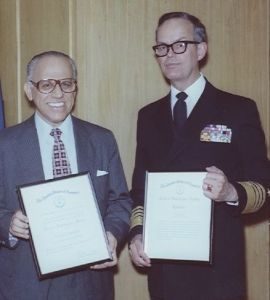 “Morley’s request had potential public value. He has proffered — and the CIA has not disputed — that Joannides served as the CIA case officer for a Cuban group, the DRE, with whose officers Oswald was in contact prior to the assassination. Travel records showing a very close match between Joannides’s and Oswald’s times in New Orleans might, for example, have (marginally) supported one of the hypotheses swirling around the assassination. In addition, this court has previously determined that Morley’s request sought information “central” to an intelligence committee’s inquiry into the performance of the CIA and other federal agencies in investigating the assassination. Under these circumstances, there was at least a modest probability that Morley’s request would generate information relevant to the assassination or later investigations.”
“Morley’s request had potential public value. He has proffered — and the CIA has not disputed — that Joannides served as the CIA case officer for a Cuban group, the DRE, with whose officers Oswald was in contact prior to the assassination. Travel records showing a very close match between Joannides’s and Oswald’s times in New Orleans might, for example, have (marginally) supported one of the hypotheses swirling around the assassination. In addition, this court has previously determined that Morley’s request sought information “central” to an intelligence committee’s inquiry into the performance of the CIA and other federal agencies in investigating the assassination. Under these circumstances, there was at least a modest probability that Morley’s request would generate information relevant to the assassination or later investigations.”
“In other words,” Henderson writes, “we held that Morley satisfied the public-benefit factor in this case,”
By ignoring this finding, Henderson argues, the majority opinion ultimately depends on the assertion that the CIA responded “reasonably” to my request. Yet, Henderson notes, the ruling also ignores the fact that the appellate court had ruled the agency’s initial response to my FOIA request was deficient on seven different legal points.
Henderson again:
“The majority discusses five in its opinion. It acknowledges that the CIA: (1) missed the 20-day statutory deadline to respond, Maj. Op. 7; (2) incorrectly referred Morley to NARA rather than responding to his FOIA request itself, Maj. Op. 7-11; (3) failed to search its operational files, Maj. Op. 11; (4) submitted an incomplete Glomar response, Maj. Op. 11-12; and (5) relied on an interpretation of Exemption 2 that was later overruled, Maj. Op. 12. It addresses these errors of law seriatim and labels them “incorrect legally,” Maj. Op. 9, but not “unreasonable.” To me, the CIA’s multiple flawed legal positions suggests that it was “recalcitrant” in declining to produce any documents before being sued. Davy IV, 550 F.3d at 1162. At the least, the errors collectively undermine the district court’s conclusion that the fourth factor “weighs heavily against Morley.” Morley X, 245 F. Supp. 3d at 78 (emphasis added).”
Henderson concludes:
“In sum, I believe the district court erred on two levels: it erred in evaluating each of the four factors individually and abused its discretion in weighing them against one another. Accordingly, this case does not call for “[d]eference piled on deference.” Maj. Op. 11. It calls for an adherence to Davy IV and our four earlier Morley opinions. Because I believe the district court ignored our mandate and misapplied our precedent, I would vacate the district court order a fifth time and remand with instructions to award Morley the attorney’s fees to which he is entitled.”
Unfortunately, the majority, meaning Kavanaugh and Trump appointee Judge Gregory Katsas, disagreed. I have 45 days to appeal.
July 6
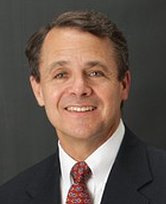 Future of Freedom Foundation, Opinion: The Mystery of Robert Knudsen, Jacob G. Hornberger (right), July 6, 2018. On January 29, 1989, the Washington Post published an obituary of Robert Knudsen, which stated in part: “He photographed … President Kennedy’s autopsy.”
Future of Freedom Foundation, Opinion: The Mystery of Robert Knudsen, Jacob G. Hornberger (right), July 6, 2018. On January 29, 1989, the Washington Post published an obituary of Robert Knudsen, which stated in part: “He photographed … President Kennedy’s autopsy.”
There is one big problem, however: Knudsen did not photograph the president’s autopsy. The official autopsy photographer was John T. Stringer, a highly respected autopsy photographer for the U.S. Navy who taught photography at the Bethesda Naval Medical School. It is undisputed that Stringer photographed the president’s autopsy and that Knudsen wasn’t even at the autopsy.
What then are we to make of this? Why would Knudsen make up a story that could easily be exposed as false?
There are two conclusions that can be reasonably drawn: First, the official autopsy of President Kennedy, which was carried out by the U.S. military, was fraudulent and, second, there is no conceivable innocent explanation for having carried out a fraudulent autopsy.
For more information, see my book The Kennedy Autopsy.
July 2
Unz Review, Opinion: American Pravda: Our Deadly World of Post-War Politics, Ron Unz, July 2, 2018. A year or so after encountering the strongly substantiated claims of [W.W. II Gen. George] Patton’s assassination, I happened to read Desperate Deception by Thomas E. Mahl, a mainstream historian, whose book was released by a specialized military affairs publishing house.
This fascinating account documented the long-hidden early 1940s campaign by British intelligence agents to remove all domestic political obstacles to America’s entry into World War II. A crucial aspect of that project involved the successful attempt to manipulate the Republican Convention of 1940 into selecting as its presidential standard-bearer an obscure individual named Wendell Wilkie, who had never previously held political office and moreover had been a committed lifelong Democrat. Wilkie’s great value was that he shared Roosevelt’s support for military intervention in the ongoing European conflict, though this was contrary to virtually the entire base of his own newly-joined party. Ensuring that both presidential candidates shared those similar positions prevented the race from becoming an referendum on that issue, in which up to 80% of the American public seems to have been on the other side.
Wilkie’s nomination was surely one of the strangest occurrences in American political history, and the path to his improbable nomination was paved by quite a number of odd and suspicious events, most notably the extremely fortuitous sudden collapse and death of the Republican convention manager, a key Wilkie opponent, which Mahl regards as highly suspicious.
Among those who grow skeptical of establishment media verdicts, there is a natural tendency to become overly suspicious, and see conspiracies and cover-ups where none exist. The sudden death of a prominent political figure may be blamed on foul-play even when the causes were entirely natural or accidental. “Sometimes a cigar is just a cigar.” But when a sufficient number of such persons die within a sufficiently short period of years, and overwhelming evidence suggests that at least some of those deaths were not for the reasons long believed, the burden of proof begins to shift.
Excluding the much larger number of less notable fatalities, here is a short list of six prominent Americans whose untimely passing during 1944-1949 surely evoked considerable relief within various organizations known for their ruthless tactics:
- Wendell Wilkie, lifelong Democrat nominated for President by the Republicans in 1940, Died October 8, 1944, Age 52, Heart attack.
- Gen. George Patton, highest-ranking American military officer in Europe, Died December 21, 1945, Age 60, Car accident.
- Harry Hopkins, FDR’s “Deputy President,” Died January 29, 1946, Age 55, Various possible causes.
- Harry Dexter White, Soviet agent who ran the Treasury under FDR, Died August 16, 1948, Age 55, Heart attack.
- Laurence Duggan, Soviet agent, Prospective Secretary of State under Henry Wallace, Died December 20, 1948, Age 43, Fall from 16th story window.
- James Forrestal, former Secretary of Defense, Died May 22, 1949, Age 57, Fall from 18th story window.
I do not think that any similar sort of list of comparable individuals during that same time period could be produced for Britain, France, the USSR, or China. In one of the James Bond films, Agent 007 states his opinion that “Once is happenstance, twice is coincidence, three times is enemy action.” And I think these six examples over just a few years should be enough to raise the eyebrows of even the most cautious and skeptical.
Foreign leaders outraged over America’s destructive international blundering have sometimes described our country as possessing physical might of enormous power, but having a ruling political elite so ignorant, gullible, and incompetent that it easily falls under the sway of unscrupulous foreign powers. We are a nation with the body of a dinosaur but controlled by the brain of a flea.


